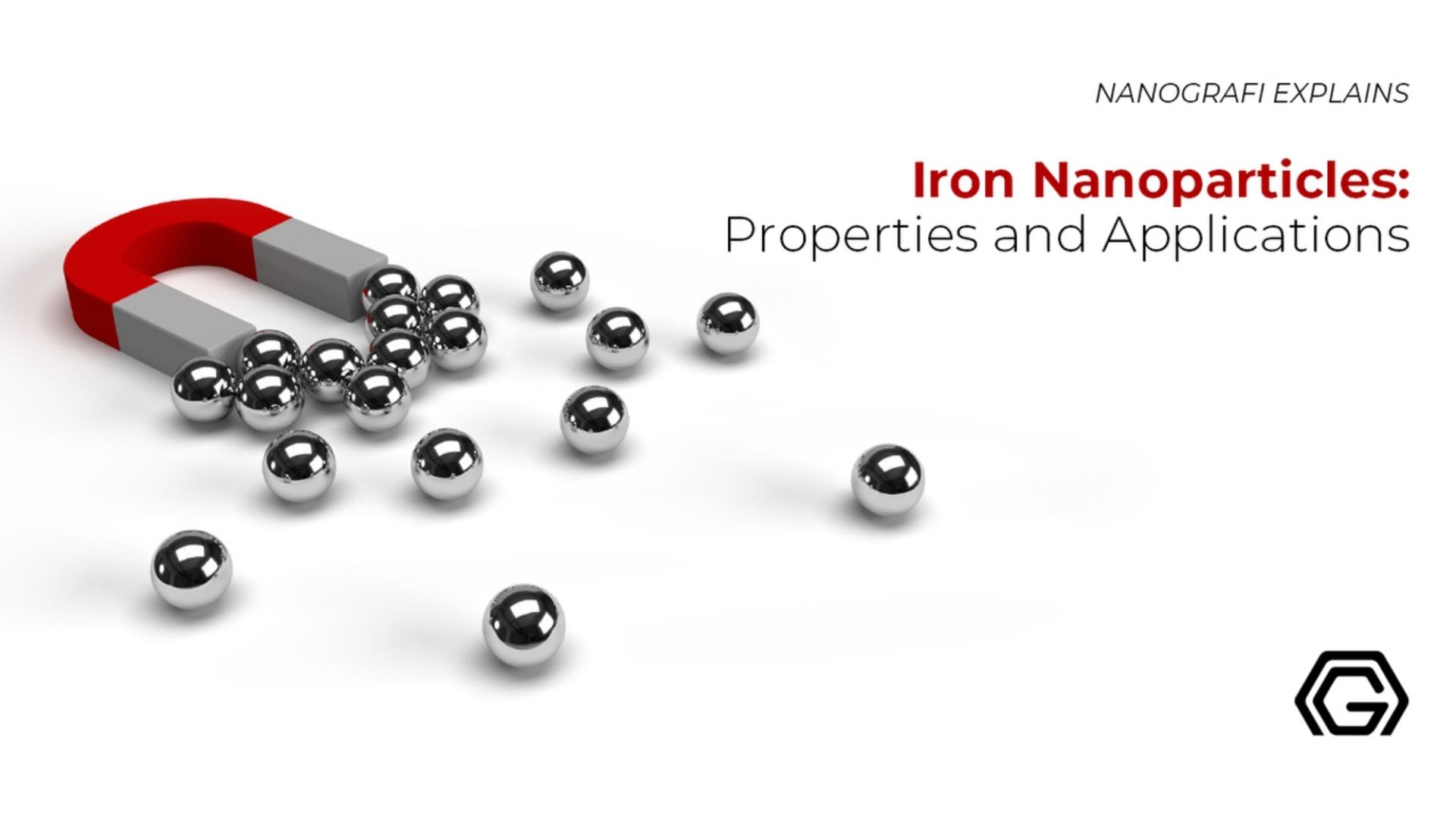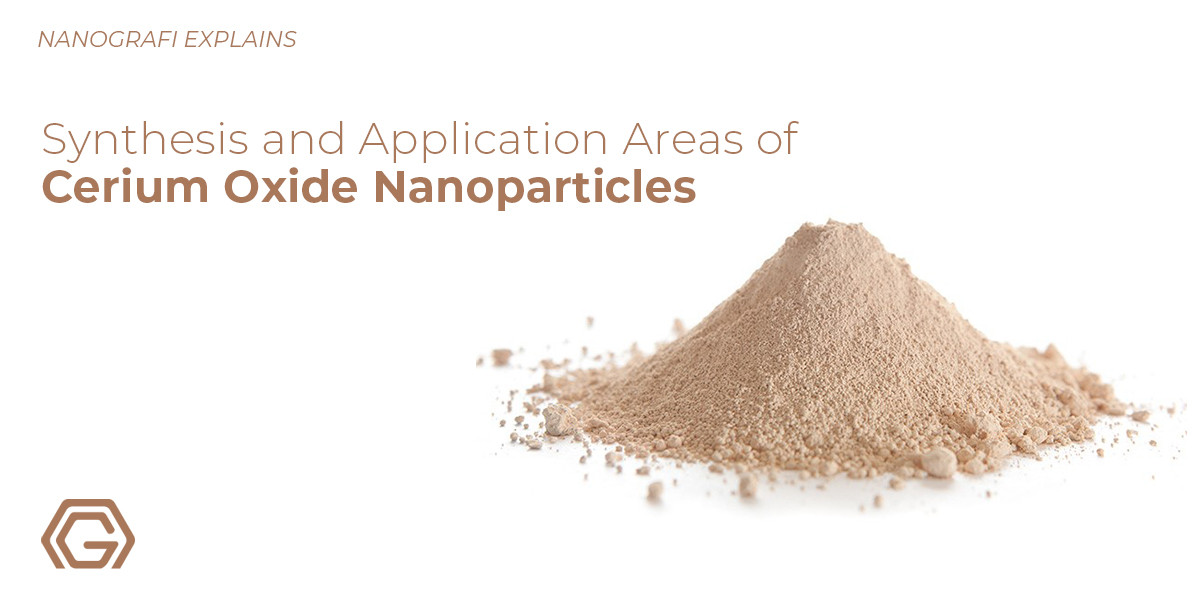Synthesis and Application Areas of Cerium Oxide (CeO2)
Nanoparticles have been playing a major role in making lives easier for humans and strengthening the role of industries throughout the world.
Over the course of the past few years, nanoparticles have progressed so much that now they are being used in almost every field and are flourishing in it like anything. Cerium oxide nanoparticles are one of the rarest earth metal particles that are now being used for multiple purposes but excelling rapidly in the field of biomedical sciences. Their properties and characteristics make them unique and profoundly more amazing to work and utilize effectively.
Introduction
A significant role is played in nanotechnology by the nanomaterials in numerous scientific fields like materials sciences, chemistry, and physics. Nanoparticles are the major component of nanomaterials, and they are single species or particles. The diameter of the nanoparticles varies from 1-10 of the nanometers.
Significant efforts have been done over the recent years for the development of the various nanocrystals/nanoparticles to develop new exciting and remarkable applications in medicine, biology, cosmetics, environmental protection, transmission, optics, data storage, sensing, energy storage, and communications. Remarkable chemical and physical characteristics can be displayed by the nanocrystals such as their magnetic, electrical, and optical characteristics, because of their high density of edge or corner surface sites and limited size.
A rare-earth metal
In the periodic table, cerium is the lanthanide series' first element and it is a rare earth metal. Cerium can exist in 2 states, 4+ and 3+ whereas most rare earth metals don't have this ability. Therefore giving it an ability to exist in the bulk state as both Ce2O3 and CeO2. Cerium has exciting catalytic characteristics because 4d and 5p electrons shield the rare earth metal's 4f orbitals sufficiently.
Cerium oxide at the nanoscale has a mix of cerium in the 4+ and 3+ states on the surface of the nanoparticle. The amount of 3+ sites increases on the surface as the diameter of the nanoparticle increases, therefore causing a loss of the atoms of oxygen (oxygen vacancies). The overall structure of CeO2−x depicts all this.
Sizes and ratios
High surface-to-volume ratios are possessed by the nanoparticles because of their lessened sizes, making them extremely reactive with distinct properties. Tuning the material’s characteristics in different ways like surface to volume ratios, morphologies, and shapes is extremely desirable. Huge efforts have been made by scientists and researchers over the past years for the development of nanoparticles with controlled size, shapes, and morphologies.
Gaseous, solid, and liquid (chemical method) media are some of the numerous potential routes of synthesizing nanocrystals. Although, the most famous methods are the chemical routes for manufacturing those nanoparticles that can provide the benefits like comparative reliability, eco-friendliness, and low cost. In addition, rigorous control can be provided by this method on the size- and shape-controlled manufacturing of the nanoparticles.
Advances in nanoparticles
Until now, there has been the development of nanoparticles of various nanomaterials, for instance, rare-earth oxides, ferrites, metal oxides, and so on. As compared to tin (60 ppm) and copper (66.5 ppm), the abundance of cerium is much higher. Cerium (Ce) is a rare-earth family metal. This material is very important from the technological point of view because of its high abundance, having a broad number of applications in different sectors like medicine, environmental chemistry, biotechnology, electrochromic thin-film application, glass-polishing materials, fuel cells, oxygen permeation membrane systems, oxygen sensors, low-temperature water-gas shift reaction, and auto-exhaust catalyst.Non-stoichiometry levels
Generally, there is a belief that at high interface densities, the lessened particle sizes can originate, and thus it can also result in improved non‐stoichiometry levels. A huge amount of attention was given to them because of this for exploring the nanostructures’ ceria interfacial redox reactions and transport characteristics as compared to bulk ceria.
Electronic structure
Cerium has many oxides but the most stable oxide is considered to be Cerium dioxide (CeO2/ceria). In the lanthanide series of the periodic table, cerium is the most reactive element and the second member in that series. Ce4+ and Ce3+ are the dual oxidation modes in which cerium exists as it is electropositive in nature. As compared to 3+, the oxidation state Ce4+ is more stable because of the electronic structure [Xe]4f0 of Ce(4+) being more stable state as empty as compared to the electronic structure [Xe]4f1 of Ce3+. Usually, cerium sesquioxide (Ce2O3) and cerium dioxide (CeO2) are cerium’s two types of oxides. However, due to higher stability than cerium sesquioxide, cerium dioxide (CeO2) is utilized as the cerium oxide in the larger context.
Importance of Oxygen Vacancies in CeO2
High oxygen deficiency can be accommodated by cerium oxide through the substitution of the lower valent elements on the sub-lattice of the cation. High oxygen ion conductivities are expected because of this characteristic as it refers toward its possible usages in solid oxide fuel cells (SOFCs) as a solid electrolyte. CeO2 is famous right now for releasing oxygen in major levels at increased temperatures and low oxygen partial pressures (PO2), resulting in a mixed ionic electronic conductivity. Multiple states of oxidation like Ce (4+) and Ce (3+) can be easily occupied by ceria because of the ease in redox-based reactions, thus, electrons in ceria can exist as small polarons. In a ceria lattice, the motion of electrons can be a thermally mediated hopping mechanism. One should take into consideration the concentration of vacancies that can contribute to oxygen-ion transport in the solid solutions and are more mobile for transports and carrier characteristics.
Nano‐size effects
Production of more oxygen vacancies is displayed by ceria nanoparticles when the size of the particle is decreased. Cerium dioxide (CeO2) has a different reaction due to its remarkable characteristics because of the nanoparticle's large surface area to volume ratio. For example, 3-CeO2 nanoparticles of 3-4 nm size were synthesized to support Au over a regular bulk cerium oxide support medium for observing two orders of magnitude high catalytic activity for oxidation of CO. Thus, tuning ceria nanoparticle’s specific reactivity is feasible by controlling the size of the ceria nanoparticles. In addition, in comparison with the bulk ceria, nano‐sized CeO2 has improved electronic conductivity, and size lattice relaxation along with various other effects.

If you are interested in Application Areas of Iron Nanoparticles,
you can read our blog post here.
Production of Cerium Oxide Nanoparticles
The preparation method determines the nanoparticle’s physicochemical characteristics. Parameters of preparation should be carefully optimized for selecting advantageous physicochemical characteristics in vivo for a bio-relevant nanoparticle. Cerium nanoparticles of different morphology, sizes, and agglomeration can result because of the different preparation methods. Generally, cerium nanoparticle’s lowered agglomeration can result in bio-relevant solution during a coating-post synthesis or synthesis by utilizing a surfactant or a polymer.
Formation of protein corona
While preparing the nanoparticle for usage in vivo, one of the main things to consider is the synthesis of a protein corona because the nanoparticle's clearance and uptake are affected by protein corona. Lynch et al. reviewed the nanoparticle-protein corona and various readers read it.
Traditional Synthesis Methods
There have been reports on the various methods to synthesize CeNPs. Sol-gel methods, thermal hydrolysis, spray pyrolysis, thermal decomposition, ball milling, solvothermal, hydrothermal, and solution precipitation are included in these methods. Lower biocompatibility is faced by various traditional methods. Generally, lower toxicity, longer retention times, and greater stability are provided by the nanoparticle's biocompatible coatings by lessening the non-specific interactions. Various coatings-polyacrylic acid, folic acid, glucose, cyclodextrin, polyethyleneimine, dextran, and polyethylene glycol (PEG) are used to functionalize CeNPs. Moreover, chelating MRI contrast agents like gadolinium can dope CeNPs for enhancing the safety of CeNPs while also demonstrating antioxidant characteristics.
Green Synthesis Methods
Bio-directed CeNP synthesis methods have attracted a lot of attention especially those that utilized natural matrices as stabilizing agents because they help in alleviating the bio-compatibility concerns. Safer routes are provided by these green chemistry methods to synthesize CeNPs and they are also very beneficial as they can be used in pharmaceutical applications. They also provide simpler alternatives and lower costs as compared to the traditional synthesis methods.
Also, the conclusion about their biocompatibility should be made only after they assess the formation of protein corona to manufacture CeNPs in biological fluid environments. There should also be an investigation on the usage of the methods of green chemistry to synthesize the CeNP’s biological characteristics and on the effect of Ce3+/Ce4+ surface ratio on those characteristics.
Strategies of Green Synthesis Method in Cerium Oxide
Nutrient-mediated synthesis, polymer-mediated synthesis, fungus-mediated synthesis, and plant-mediated synthesis are the main strategies that are involved in CeNPs’ green synthesis. Plant extracts function as capping and stabilizing agents in plant-mediated methods (photosynthesis). Plant-mediated methods (photosynthesis) lead to comparatively large CeNPs as the current ones are not good enough for applications in biomedicine.
Smaller CeNPs are produced to resolve mycosynthesis (fungus-mediated methods). Those CeNPs have high fluorescent, higher water dispersibility characteristics, and more stability. Natural polymers can function as stabilizers and helps in CeNPs’ green synthesis. For instance, PEG is utilized for creating dispersible nanopowders in aqueous solutions. The utilization of nutrient-mediated synthesis as a substrate is very cost-effective for synthesizing CeNPs. Egg white proteins function as stabilizers leading to small CeNPs controlled isotropic growth.
Bio-Relevant Activities of Cerium Oxide Nanoparticles
Enzyme Mimetic Activities
- Degradation through catalase:
H2O2 is a potentially harmful oxidizing agent and catalase can degrade it. Higher catalase-mimetic activity is displayed by the CeNPs with low 3+/4+ ratios as compared to the CeNPs that have high 3+/4+ ratios. In order to read a brief overview of these activities’ mechanisms, readers can read the review that Celardo et al. wrote. CeNPs can be transformed into remarkable antioxidants if these activities are coordinated as both catalase-mimetic and SOD-mimetic activities are possessed by CeNPs.
- Phosphatase Mimetic Activity
Phosphatases are enzymes. Phosphatases remove groups of phosphate from their substrate through esters' hydrolysis into the phosphate ions. Phosphatase-mimetic capabilities are displayed by CeNPs with low 3+/4+ ratios for both bio-relevant substrates and artificial phosphate substrates just like it is for the catalase-mimetic activity. Although, recently it was exhibited that distinct active sites are possessed by the phosphatase-mimetic activity as compared to those for catalase-mimetic activity. Due to the abundance of phosphate anions in the biological solutions, it is very significant that one considers the interactions of CeNPs with phosphate anions for decreasing the SOD-mimetic activity while increasing the catalase-mimetic activity.

If you are interested in Applications of Hydrothermal Synthesis Autoclave Reactors,
you can read our blog post here.
Evidence for Bio-Relevant Activities of Cerium Oxide Nanoparticles
Here, there are pieces of evidence of the antioxidant activities of the CeNPs by the reader. Each synthesis method that is utilized is listed in each synopsis and it is significant to the researchers that they remember these methods before using the same strategies in the new experiments. It is a request to readers to read Das et al.’s comprehensive review.
In Vitro Studies
CeNPs protective effects on primary human skin fibroblasts were displayed by Pezzini et al. especially those that were exposed to a pro-oxidative insult. Alfa Aesar gave the monodispersed CeNPs with 2 nm of the average diameter. After 1 and 3 days of incubation with CeNPs, fibroblast proliferation was assessed at 200, 100, and 0 µg/mL concentrations. CeNPs were internalized and they exhibited strong ROS scavenging activity and didn’t affect the fibroblasts viability. Moreover, mitochondrial function was affected by CeNPs by increasing the production of ATP, but it also preserved the potential of the membrane of mitochondria. This research is proof of CeNPs applications for a broad number of conditions.
Redox-active cerium oxide nanoparticles
Redox-active CeNPs are utilized for cancer therapy in combination with a therapeutic conventional, doxorubicin, according to Sack et al. observations. Karakoti et al. told that the CeNPs that this study used, were made specifically. Apoptosis, cell-cycle arrest, and DNA damage primarily mediate doxorubicin's antitumor activity. Doxorubicin doesn't only affect cancer cells, it also influences healthy cells. CeNPs’ antitumor activity with doxorubicin was compared by the authors and they established that in human melanoma cells (A375 cells), doxorubicin’s antitumor activity was enhanced by CeNPs, in the context of oxidative damage, ROS formation, and cytotoxicity.
Cytotoxic effects were exerted by both doxorubicin and CeNPs on the A375 cells and when CeNPs and doxorubicin are utilized together, A375 cell’s viability decreased more as compared to the decrease in its viability with each agent alone. In addition, doxorubicin’s toxic effects on human dermal fibroblasts (HDFs) were abolished by CeNPs.
Strategies in cancer therapy
Novel strategies are offered by such kinds of approaches in cancer therapy. CeNPs potential usages in brain tumor-related treatment have also been investigated by the same group. According to Sack-Zschauer et al., while CeNPs were protecting the healthy cells from damage, they also killed malignant glioma cells. 1.27 mg/mL of sodium polyacrylate was used to stabilize CeNPs which was bought from Sciventions. According to the authors, no cytotoxicity was displayed by CeNPs towards microvascular endothelial cells whereas they had a cytotoxic effect on anaplastic astrocytoma cells.
Leukemia cells
It was established by Patel et al. that CeNPs’ uptake and free radical scavenging capability can be evaluated by human monocyte leukemia cells (THP-1 cells) which are utilized as a model. Hirst et al. described the synthesis of CeNPs by doing slight alterations to a basic method. In THP-1 cells, there was an increase in CeNPs’ internalization in a concentration-dependent manner between 10-100 µg/mL. Moreover, ROS amount was lessened by CeNPs without displaying any cytotoxicity. Therefore, instead of inducing the generation of ROS in the cytoplasm like any other oxide nanoparticles, the antioxidant activity was retained in the cytoplasm by CeNPs after quick internalization by THP-1 cells.
Cytotoxicity
High concentrations of CeNP were demonstrated by Sadhu et al. in tobacco BY-2 cells induce cytotoxicity and damage metabolic activity whereas antioxidant activity is exhibited when there are low concentrations of CeNPs. Sigma-Aldrich Chemical Co. gave the CeNPs that this study utilized, all of which were under 25 nm. For 24 hours, tobacco BY-2 cells were treated by authors with 250, 50, and 10 µg/mL of CeNP concentrations.
For higher concentrations of CeNP, major alterations and DNA damage in antioxidant defense systems were seen. Also, genotoxicity was not induced by CeNPs at 10 µg/mL of concentration and that resulted in lessened DNA breakage in the cells that were exposed to H2O2. These results indicate towards CeNPs’ alternative autophagy-mediated, gene-protective role, and antioxidant.
In Vivo Studies
Synthesis and design of triphenylphosphonium-conjugated CeNPs were reported by Kwon et al. as they localized to mitochondria and repressed the death of neurons in Alzheimer’s disease model. Hydrolytic sol-gel reactions were used to synthesize CeNPs. ROS's abnormal levels can be caused by mitochondrial dysfunction and it can result in neuronal cell death subsequently. One of the great therapeutic approaches for neurodegenerative disease is targeting CeNPs to mitochondria.
Positively charged and small triphenylphosphonium-conjugated CeNPs were synthesized by the authors and they can localize mitochondria in numerous cell lines and can mitigate reactive gliosis while suppressing the death of the neurons. This can function as a great technique for developing mitochondrial therapeutics for neurodegenerative diseases like Alzheimer’s disease.
Tumor growth in ovarian cancer
According to the facts shown by Hijaz et al., the growth of tumors in an ovarian cancer xenograft nude model was majorly reduced by CeNPs. Das et al. and Cimini et al. used a synthesis strategy based on methods that were utilized for making folic acid-CeNPs and CeNPs. Intra-peritoneal injections were given to A2780 generated mouse xenografts as they were treated with 4 mg/kg cisplatinum, 0.1 mg/kg folic acid-CeNPs, and 0.1 mg/kg CeNPs. Lower tumor burden was carried by the mice who were treated with folic acid-CeNPs as compared to the mice who were treated only with the CeNPs. Tumor burden was further decreased when they combined cisplatinum with the folic acid-CeNPs. Moreover, vimentin expression was lessened by the folic acid-CeNPs, and that points towards a possible capability of limiting the ovarian tumor metastasis.
Retinitis pigmentosa
P23H-1 was used by Wong et al. for understanding the duration and cellular mechanisms of the catalytic activity of CeNPs to prevent photoreceptor cell loss. According to Karakoti et al., wet chemistry methods were used to prepare CeNPs. There was an observation of an increase in the post-injection function of cone and rod cells. Moreover, treatment by CeNP results in a lessening in the lipid peroxidation and apoptotic cells in the retinas. This research adds in the rodent retinal disease models list that exhibits a delay in the disease progression.
Obesity treatment
CeNPs’ antioxidant effects were investigated by Rocca et al. as an approach to treat obesity in the Wistar rats. CeNPs hindered the accumulation of triglyceride and caused an interference with the adipogenic pathway. Sigma gave CeNPs and their properties were the same as those that Ciofani et al. utilized in his famous study. At 0.5 mg/kg dose, CeNPs were intraperitoneally administered two times a week in 500 μL of sterile water for 6 weeks. After in vivo treatment, the transcriptional analysis took place and revealed an upregulation of Irs1 and Klf4 expression and a down-regulation of Ddit3,Angpt2,Twist1, Bmp2, and Lep. In conclusion, CeNPs reduced weight gain and lessened the plasma levels of triglycerides, glucose, leptin, and insulin.
Treatment of hepatic ischemia
Utilization of CeNPs in prophylactic treatment was investigated by Manne et al. and the investigation was done on Sprague Dawley rats and while treating hepatic ischemia-reperfusion injury in them. Median and left lateral lobes were induced with partial hepatic ischemia for 1 hour. Reperfusion for 6 hours followed it. On prophylactic treatment at 0.5 mg/kg with CeNPs result in a decrease in plasminogen activator inhibitor-1, myoglobin, human growth-regulated oncogene (GRO)/keratinocyte chemoattractant (KC), macrophage inflammatory protein-2, macrophage-derived chemokine, hepatocyte necrosis, lactate dehydrogenase, and alanine amino transaminase.
Conclusion
Cerium oxide nanoparticles have been progressing excessively in the field of biomedical sciences as they are being the major source of treatment of various deadly diseases. All of these applications are not only proved essential for humans but are being a major help in making the industries flourish all over the world. The researches conducted in this regard have been solid proof of the advancements and the establishments.
To get more information, you can visit our Blografi.
References
https://www.ncbi.nlm.nih.gov/pmc/articles/PMC6116044/
https://www.intechopen.com/books/functionalized-nanomaterials/cerium-oxide-nanostructures-and-their-applications
https://www.sciencedirect.com/science/article/pii/B9780128156612000074
https://pubs.rsc.org/en/content/articlelanding/2020/ra/d0ra04736h
Recent Posts
-
Advanced Materials for Unmanned Aerial Vehicle (UAV) Protection Against Laser
Consider a UAV on a critical mission, rendered inoperative by a sudden laser attack. With the increa …26th Jul 2024 -
Simulation and Modeling of Material Properties
Our world is composed of a dazzling array of materials, each with its own unique properties that dic …19th Jul 2024 -
Advanced Coatings for Superior Corrosion and Wear Resistance
Corrosion and wear pose significant challenges across various industries, leading to substantial eco …12th Jul 2024






